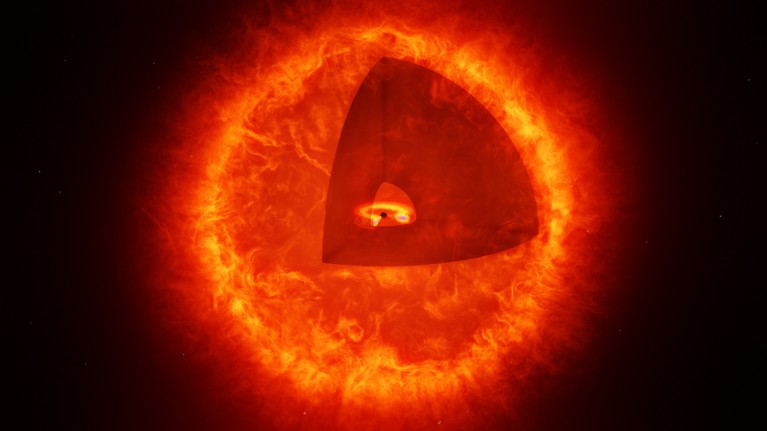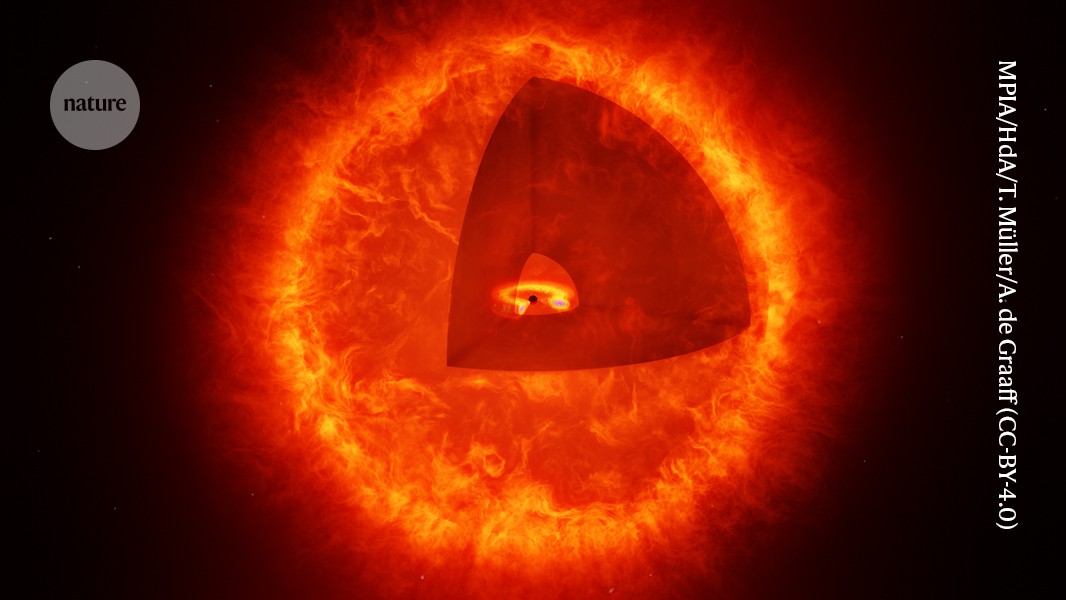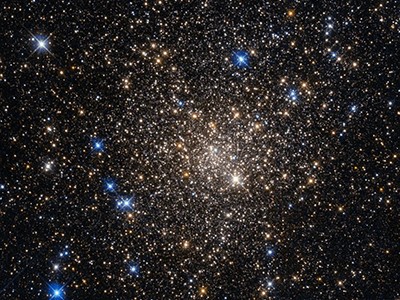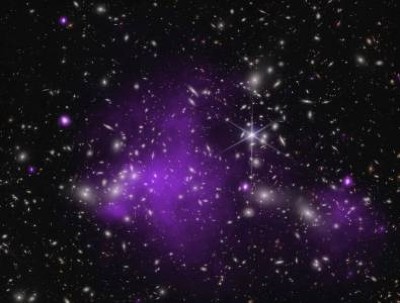
An artist’s impression of a black hole star, the explanation favoured by many astronomers for the little red dots.Credit: MPIA/HdA/T. Müller/A. de Graaff (CC-BY-4.0)
When the James Webb Space Telescope (JWST) looked back in time to observe the Universe’s earliest moments, it presented astronomers with something most peculiar: hundreds of ‘little red dots’ that inexplicably freckled the ancient cosmos.
The specks, named for their compact size in JWST images and their emission of long, ‘red’ wavelengths of light, initially baffled astronomers. They seemed too condensed to be galaxies, yet didn’t emit the right kind of light to be black holes. Researchers quickly dubbed the dots, which JWST first detected in 2022, Universe breakers, because they contradicted standard thinking about the features of the early Universe.
Over the past few months, researchers have begun to settle on the identity of these dots, and it’s one that seldom emerges in astronomy: a brand-new type of celestial object. “It’s extremely rare that you get to work on a truly new physical phenomenon like this,” says Anna de Graaff, an astronomer at the Max Planck Institute for Astronomy in Heidelberg, Germany. “It’s almost a shame that we’re starting to figure them out.”
Could JWST solve cosmology’s big mystery? Physicists debate Universe-expansion data
Many scientists now think that little red dots (LRDs) are a hybrid between a black hole and a star: an active black hole wrapped in a cocoon of hot, dense gas — much like the atmosphere of a star — that glows as the black hole warms it. A more classic black hole, by contrast, doesn’t shine in the same way.
Even as astronomers decide on a frontrunner theory on the nature of these mysterious dots, often called rubies, they are left with more questions: did LRDs exist only in the most ancient Universe, or are they also present in more modern stretches of the cosmos? How do they evolve over time? And how do they form in the first place?
Just three years after JWST’s first observations of these dots, some 200 manuscripts investigating LRDs have been posted to the arXiv preprint server (some of these manuscripts have not yet been peer reviewed). Here, Nature rounds up a few of the bright specks of research — all described in the past three months — that are illuminating this tantalizing new class of object.
A remarkable ruby
Perhaps the most pivotal LRD is an object called the Cliff, which makes the strongest case yet for the black-hole-star model. This object got its name because of the sharp break in the spectrum of light it emits: in a graph that shows the wavelengths of light radiated by the object at one point in time, its emissions are almost zero for ultra-violet light just outside the visible spectrum but they spike suddenly for slightly less energetic wavelengths of light.
Giant black hole is one of the earliest ever seen — with clues for how these weird objects form
“The sharp transition is not something normal galaxies can make,” says de Graaff, a co-author of a paper1 describing the results that was published last month in Astronomy and Astrophysics. “And black holes in the nearby universe also don’t look like that. So this was the first object that could rule out a huge array of models.” The authors of the paper accordingly refer to the Cliff as a “remarkable ruby”.
Analysis of the spikes of light indicates that the object must be extremely energetic — like a black hole — but must also be encased in warm, dense gas similar to the atmosphere of a star. The team’s explanation of the object matched well with a model described earlier this year of a black hole swaddled in gas, and thus, the black hole star was born.
Galactic pack
In addition to solidifying what LRDs are, astronomers are curious as to how they evolve. Some think such rubies could become the centres of galaxies.
As they reported in Nature Astronomy3 last month, one team of researchers is beginning to zero in on a potential answer. The LRD starring in their paper was surrounded by eight nearby galaxies and embedded in an especially large blob of dark matter, the invisible entity that binds groups of galaxies together, says study co-author Jan-Torge Schindler, an astronomer at the University of Hamburg in Germany. Such a large dark-matter halo usually hosts quasars, extremely bright cores at the centres of some galaxies.




